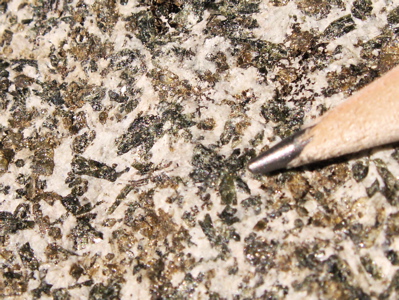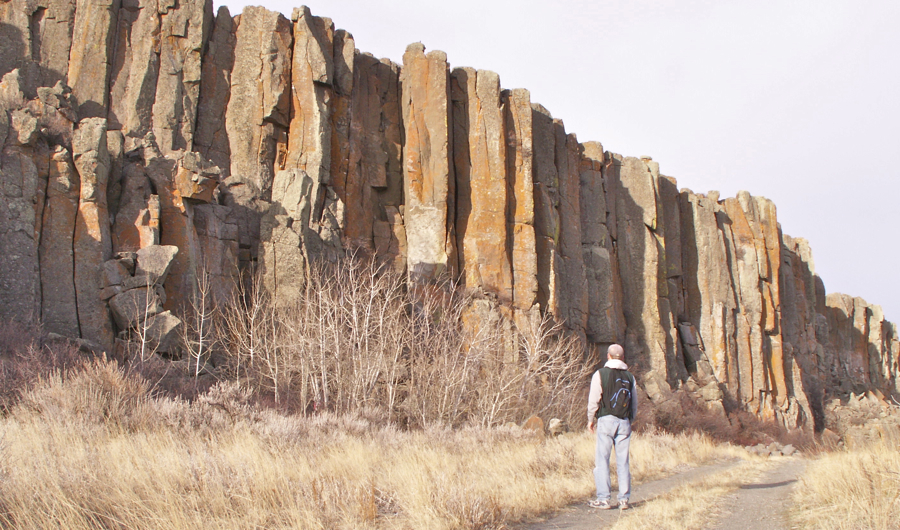|
Snake Butte on the Ft. Belknap Reservation 
Click here to see a larger version of the photo.
A Landmark on the Hi-Line. . .
Snake Butte is located 10 miles south of Harlem on the northern part of the Ft. Belknap Reservation. Travelers in the Harlem area are treated to a view of Snake Butte between the Little Rockies and the Bear Paws (Bear's Paw Mountains) on the southern horizon. The Little Rockies are actually 25 miles south of Snake Butte and the Bear Paws begin 15 miles to its southwest. A portion of the Bear Paws can be seen on the right side of the photo above. The geology of Snake Butte is fascinating, but it is also an important spiritual place for Native Americans, and played a major role in one of the biggest construction projects in Montana's history.
A Spiritual Place . . .
High places that stand above the prairie are often considered sacred to Native Americans. Snake Butte is such a place, and one of the ways it has been used by Native Americans is for the spiritual experience called a "vision quest". Although every tribe has different beliefs and ceremonies, the quest is an intensely private experience that often begins by cleansing the body through sweat-lodge purification. Next, the person withdraws to a secluded location for three to four days, where they fast and pray in order to seek a vision experience. The Snake Butte area is also home to the Ft. Belknap bison herd
Volcanism in North-Central Montana . . .
 The reason the Snake Butte is a high place has to do with its connection to an ancient center of volcanic activity. It is made of igneous rock (formed as magma or lava hardens) . . . In this case the magma hardened underground, therefore Snake Butte is classified as an intrusive igneous formation. The magma that became Snake Butte originated from the same volcanic center that formed the Bear Paws. On the other hand the Bear Paws are an extrusive igneous formation, formed as lava cooled on the surface. The Bear Paws are the remnants of an area where volcanoes were active 50 million years ago.
The reason the Snake Butte is a high place has to do with its connection to an ancient center of volcanic activity. It is made of igneous rock (formed as magma or lava hardens) . . . In this case the magma hardened underground, therefore Snake Butte is classified as an intrusive igneous formation. The magma that became Snake Butte originated from the same volcanic center that formed the Bear Paws. On the other hand the Bear Paws are an extrusive igneous formation, formed as lava cooled on the surface. The Bear Paws are the remnants of an area where volcanoes were active 50 million years ago. Formed beneath the surface . . .
In some places magma beneath this volcanic center moved through cracks in surrounding sedimentary rock (dikes) and forced its way between layers of sedimentary rock (sills) where it cooled slowly. This slow cooling gave minerals time to form larger crystals (see photo to right). Click here to see a larger photo. Eventually the crystals grew into each other, forming interlocking grains that give the rock its durability. This appearance (texture) is referred to as "course-grained". . . Granite is the most common type of course-grained igneous rock. The granite-like rock that Snake Butte is made of is known as "syenite". In the millions of years after the magma hardened beneath the surface, less durable sedimentary rock above and around it eroded away and the rock of Snake Butte was exposed. The Bear Paws, the Highwoods, and the mountains between Craig and Cascade are all made of durable igneous rocks. Click here to see where igneous rock can be found in Montana.
Columns of Stone . . .
Visitors to Snake Butte will see a feature of igneous rocks called "columnar jointing", which is sometimes present where igneous rock is exposed. Columnar jointing happens when lava or magma shrinks as it hardens, causing it to crack into neat geometric columns. The columns found on the northern and eastern cliffs of Snake Butte are especially large as shown in the photo below. Large columns can also be seen in some places on the top. Click here to see a photo. 
Igneous Rocks Chosen for the Dam . . .
Because of its especially durable igneous rock, Snake Butte was an important source of material used to build Ft. Peck Dam in northeastern Montana from 1933-1940. Since most of the rock in eastern Montana is sedimentary rock, which was unsuitable for the dam, the tough syenite of Snake Butte was chosen for the project. The butte's proximity to the Great Northern Railway supported this choice. Rock quarried from Snake Butte was hauled by rail 10 miles into Harlem and then onto the construction site near Glasgow 100 miles to the east. Click here to see the location of an abandoned quarry on the north side of Snake Butte. Click here to see where the rocks quarried from Snake Butte ended up.
Speaking of trains . . .
 Three other strange features tell of another chapter in Snake Butte's past. One is the presence of foreign rocks on top of the butte. You can find occasional metamorphic rocks that came from Canada like the orange one in this photo. These "erratics" came with the ice and were left when the ice melted. Another odd feature is the presence of huge pieces of Snake Butte strewn in a line for several miles to the southeast of the butte, crossing highway 66 about 10 miles south of Ft. Belknap Agency (photo). The line of boulders (some as big as cars) is called "The Snake Butte Boulder Train". The third unusual feature are scratches, called "striations", made by rocks stuck to the bottom of a glacier (photo). All three features were caused by a continental glacier that grew southward from Canada during the last ice age. The striations show that the ice was flowing southeast as it went up and over the butte (photo). Metamorphic rocks that became embedded in the ice far north of the border were deposited across northern Montana as the ice melted over 15,000 years ago. The presence of Canadian rocks on the butte proves that the ice moved over it. The boulder train confirms this, and also shows that the ice was flowing toward the southeast as it moved through here. As the ice flowed over Snake Butte, it scraped off pieces of the butte and scattered them along a line that extends to the southeast. Diagram (modified) courtesy of Roadside Geology of Montana by David Alt and Donald W. Hyndman. Three other strange features tell of another chapter in Snake Butte's past. One is the presence of foreign rocks on top of the butte. You can find occasional metamorphic rocks that came from Canada like the orange one in this photo. These "erratics" came with the ice and were left when the ice melted. Another odd feature is the presence of huge pieces of Snake Butte strewn in a line for several miles to the southeast of the butte, crossing highway 66 about 10 miles south of Ft. Belknap Agency (photo). The line of boulders (some as big as cars) is called "The Snake Butte Boulder Train". The third unusual feature are scratches, called "striations", made by rocks stuck to the bottom of a glacier (photo). All three features were caused by a continental glacier that grew southward from Canada during the last ice age. The striations show that the ice was flowing southeast as it went up and over the butte (photo). Metamorphic rocks that became embedded in the ice far north of the border were deposited across northern Montana as the ice melted over 15,000 years ago. The presence of Canadian rocks on the butte proves that the ice moved over it. The boulder train confirms this, and also shows that the ice was flowing toward the southeast as it moved through here. As the ice flowed over Snake Butte, it scraped off pieces of the butte and scattered them along a line that extends to the southeast. Diagram (modified) courtesy of Roadside Geology of Montana by David Alt and Donald W. Hyndman.
Bigskywalker.com - Blog Post/Photo Tour: Snake Butte
Terms: syenite, sill (Snake Butte is a sill.) NOTE: According to the "Geologic Map of Montana" (2007 Montana Bureau of Mines and Geology), the rock of Snake Butte is "syenite". However, some geologists classify it as "shonkinite".
| 



